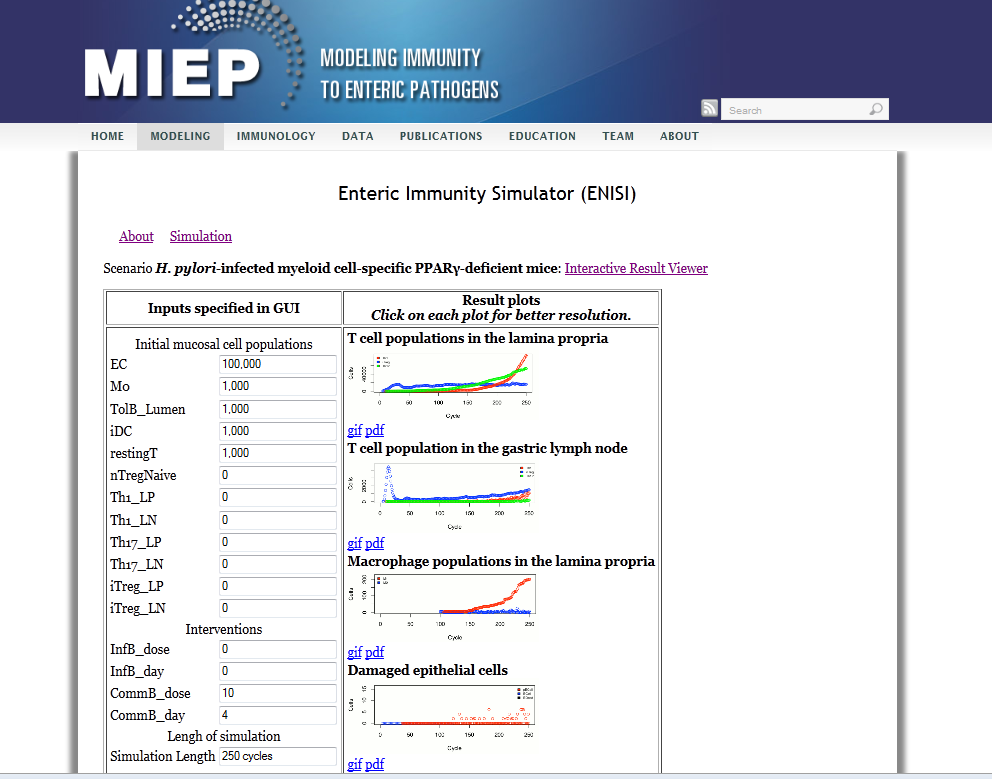Center for Modeling Immunity to Enteric Pathogens Releases a Revolutionary Modeling and Simulation Software: Enteric Immunity Simulator
BLACKSBURG, Va., Oct. 5th, 2011 – Researchers from the Center for Modeling Immunity to Enteric Pathogens (MIEP) at the Virginia Bioinformatics Institute have released an upgrade to the revolutionary ENteric Immunity SImulator (ENISI) software. The ENISI models immune responses to beneficial and harmful bacteria that enter the gastrointestinal tract (GI) of mice, pigs and humans. ENISI allows users to create enteric systems such as the gut-associated mucosal immune system in silico, providing a better glimpse of how the immune system responds to pathogens that invade the bacteria-rich environment of the gut. “ENISI is unique because it’s specific to the gut, simulating each individual cell rather than creating broad mathematical models,” said researcher Ms. Kate Wendelsdorf. “Thus, it’s more faithful to a living system and allows us to simulate a million individual cells, more than any other simulator. It’s a powerful tool for understanding interactions between gut pathogens and the mucosal immune system.”
 The ENISI software allows researchers to model the immune responses that occur when a pathogen invades the GI tract. Researchers can manipulate cells and immune processes in ENISI to determine if, for example, blocking a specific immune pathway or adding a drug can inhibit pathogen invasion and infection. The computer-generated models created in ENISI can, in turn, help researchers design better experiments to test the simulations in laboratory settings or in live animals. Therefore, it may be possible to test the efficacy of a novel vaccine or immune therapeutic in an ENISI model of disease, confirm the results in an animal model, and then use those results to explore the mechanisms of therapeutic efficacy in additional studies.
The ENISI software allows researchers to model the immune responses that occur when a pathogen invades the GI tract. Researchers can manipulate cells and immune processes in ENISI to determine if, for example, blocking a specific immune pathway or adding a drug can inhibit pathogen invasion and infection. The computer-generated models created in ENISI can, in turn, help researchers design better experiments to test the simulations in laboratory settings or in live animals. Therefore, it may be possible to test the efficacy of a novel vaccine or immune therapeutic in an ENISI model of disease, confirm the results in an animal model, and then use those results to explore the mechanisms of therapeutic efficacy in additional studies.
ENISI was initially designed to model inflammatory bowel disease (IBD) and the recent upgrade allows investigators to simulate immune responses in a mouse infected with Helicobacter pylori. The MIEP team has plans to expand the ENISI software to simulate infection with enteroaggregative Escherichia coli and other enteric pathogens such as Clostridium difficile and Cryptosporidium parvum. Future ENISI upgrades will allow users to run simulations via the MIEP website and will eventually be able to visualize in silico cells or lesions forming in real time, rather than only seeing the outcomes of such interactions. This feature will help immunologists and infectious disease experts immensely in understanding pathology, diagnosis, and treatment.
“ENISI is based on an interaction-based modeling approach that represents individual cells and their interactions with other cells, pathogens, and the environment. The algorithmic/procedural representation of individual agents and their interactions with other agents via an abstract interaction network is central to the modeling process. The use of high-performance computing facilitates scaling to 106 cells; we expect this number to grow 100-fold over the next two years. Such a representation yields a fundamentally different approach to understanding novel immunological processes,” said Dr. Madhav Marathe, MIEP’s modeling lead.
“ENISI runs on high-performance computers: hundreds or thousands of servers working together to produce an answer. The MIEP program shows the power of trans-disciplinary science, bringing together a team of software developers, computer scientists, immunologists, and physicists to solve problems that they wouldn’t have been able to tackle on their own,” said Dr. Keith Bisset, a MIEP modeling expert and a key developer of the ENISI software.
A MIEP team paper entitled Enteric Immunity Simulator: A tool for in silico study of gut immunopathologies has been accepted in the IEEE Bioinformatics and Biomedicine (BIBM) International conference proceedings. Preliminary ENISI modeling results that simulate bacterial-induced colitis will be presented at the IEEE BIBM conference later this year.
“One of our goals in the MIEP program is to develop user-friendly and interactive modeling tools that engage and inform the immunology and infectious disease communities, thereby enabling paradigm-shifting scientific discovery. The release of the upgraded ENISI software by the MIEP team is a major step in allowing powerful computer simulations to uncover novel mechanisms of immunoregulation underlying immune responses to gut pathogens. The ultimate goal of such powerful simulations is to accelerate the discovery of novel drug targets and biomarkers for enteric infectious diseases. The fully integrated computational modeling, bioinformatics and immunology experimentation efforts within the MIEP program enable the generation of mechanistic evidence in silico and efficient validation in vivo,” said Dr. Josep Bassaganya-Riera, MIEP’s principal investigator and Director of the Nutritional Immunology and Molecular Medicine Laboratory.
For more information about ENISI please visit the MIEP Web Portal at www.modelingimmunity.org. MIEP is funded by the National Institute of Allergy and Infectious Diseases (NIAID), part of the National Institutes of Health, under NIAID’s Modeling Immunity for Biodefense program.
About NIMML
The NIMML Institute is a 501 (c) (3) non-profit public charity foundation focused on a transdisciplinary, team-science approach to precision medicine at the interface of immunology, inflammation, and metabolism. The NIMML Institute team has led numerous large-scale transdisciplinary projects and is dedicated to solving important societal problems by combining the expertise of immunologists, computational biologists, toxicologists, modelers, translational researchers, and molecular biologists. The Institute is headquartered in Blacksburg, VA. For more information, please visit www.nimml.org or contact pio@nimml.org.
